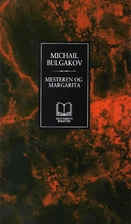Translated with notes by Richard Pevear and Larissa Volokhonsky. Introduction by Richard Pevear.
The Master and Margarita teases the reader in many ways: improbable people and the supernatural activities they engage in confound you a little at the outset. But as with any consistent narrative we learn to expect traits and characteristics; outcomes begin to gratify us, and treat us to a series of accelerating surprises.
Bulgakov composed and revised Master between 1928 and 1940. (He died in 1940, a short time after dictating the last revisions.) It contains multiple narrative threads, each with its own style and level of speech. There is a prominent story featuring Pontius Pilate, a close and almost sympathetic portrait that includes forgiveness for the Procurator. Moscow’s ordinary citizens populate another strand, and they exhibit pomposity, cynicism, greed, and jealousy. The main players, the writer called the Master, his lover Margarita, and a poet named Homeless emerge with deeper coloring, and a lot more sympathy. The third distinct thread folds in the eerie and omnipotent Satan and his retinue, slumming in Moscow for a time.
These three skeins have something in common: they each prominently display themes and scenes forbidden from Soviet literature under Stalin. Master and Margarita first saw light when it was serialized in the Soviet Union in 1966 and it caused an immediate sensation. We encounter many scenes which satirize and vilify the Soviet police state, sometimes through the use of a code word, like “sitting,” a term for incarceration in a work camp or prison. Or when citizens disappear, Bulgakov’s narrator says no one knows where, such a mysterious thing! The book almost certainly would have made Bulgakov disappear had it appeared in his lifetime.
The mix of fanciful, almost fairy tale aspects, with the everyday drabness and shiftiness of Moscow life, sharpens both into crystal focus. This juxtaposition proves Bulgakov’s brilliance. It makes several points clearly, unmistakably: there is a desperation and dreariness to life when it contains no freedom; the devil is all-powerful and you may need his services to achieve a happy ending; certain citizens live a life of luxury and work assiduously to keep others from it. Lay over the top of these observations a vivid, remarkable picture of Pontius Pilate in his moment of cowardice and doubt, and the whole sparks and trembles and shifts in our consciousness. It’s a product of its time and place, but that doesn’t stop it from being brilliant, a masterwork.
I don’t usually read introductions to books, preferring to let the work settle on me with my own set of views and experience. But after finishing Master and Margarita I took up Richard Pevear’s introduction, and if more were like his, I would definitely read more. He impresses with his knowledge of the book’s compositional history, and makes a number of compelling observations about the historical and political milieu in which it was written and then published. His observations on the text are astute and helpful, and the end notes eminently useful. This introduction definitely adds something to the reading, which a good introduction should.
Take up Bulgakov’s parable. See what all the fuss is about.



















No comments
Post a Comment